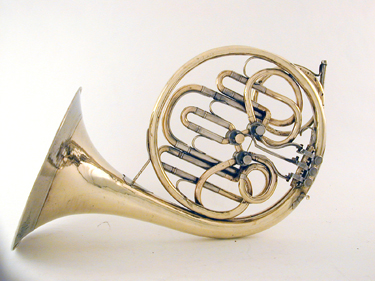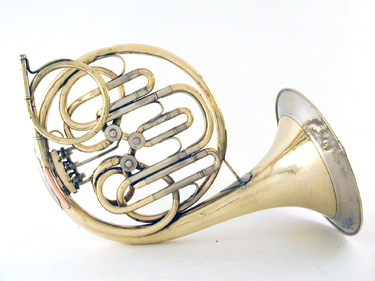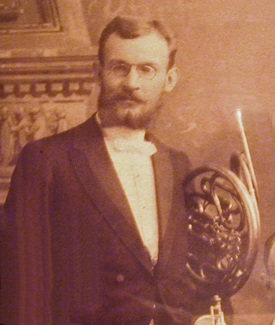| Label :
|
Anton Holy Plzni Sp. Voj. Vysl. v Plzni |
|
|
Model:
|
single |
|
|
Serial Number:
|
none |
|
|
Date of Manufacture:
|
ca.1890? |
|
|
Key(s):
|
F or E♭ (and A?) depending on terminal crook | |
|
Valves:
|
3 rotary (triangular pattern) |
|
|
Bore:
|
1.135 cm. |
|
|
Bell Flare:
|
with nickel-silver garland |
|
| 6.1 cm. |
||
|
Bell Diameter:
|
28.5 cm. |
|
|
Base Metal:
|
brass with nickel-silver trim |
|
|
Finish:
|
unlacquered |
|
| . (click on photos for larger view) |
||
 |
 |
|
The arrangement of rotary valves in a triangular pattern was not uncommon among horn makers in Bohemia and the vicinity of Vienna as an alternative to the Vienese pumpen valves. This innovation was no doubt an attempt to reduce the "acoustic resistance" due to the sharp angles of tubing found in the valve clusters of the Vienna horn and in-line rotary valves. Other examples of triangular valve arrangement are known by Josef Müller, Prague; Leopold Uhlmann, Jr., Vienna; Josef Glassl, Graslitz; Jos. Fotter, Mladá Boleslav, Bohemia, Friedrich Gessner, and Josef Wolf. The modern Czech firm, M.Jiracek a Synove, makes a similar Double Horn (Model Nr.101 "Supin") in F and B♭ with four rotary valves arranged in a square. "This unique design allows the airstream to pass through the valves unidirectionally - with acoustic resistance reduced incredibly." |
||
 |
||
Antonin Holý (or Anton Holly1 ; 1835-1926) was born in Velké, Lohovice near to Radnice. He was the son of Vojtěch Holý, overman (foreman), working earlier as a teacher assistant, and Ann Mitterbach from Jáchymov, Antonin studied lutherie and violin making in Prague. He also became fine cellist and was associated with violinist Ferdinand Laube, the Onříček Family, Antonín Dvořák and Otakar Ševčík. In 1864 he displayed a flugelhorn in C and euphonium, and from 1865 to 1897 he was making and selling brass instruments. He worked in Vienna before settling in Pilsen, Bohemia (now Czech Republic), where he was interested in the musical life and national fight.2 In 1880 he received a burgess-ship in Pilsen because of his work and by 1891 he had a workshop at Velesvlavínová st. No. 11. There there is also a listing: "Holy Anton, Weleslavingasse 11. Brass instrument workshop and shop with string instruments and percussion instruments." In addition to supplying musical instruments to Pilsen and vicinity in the late nineteenth and early twentieth century, he also exported to the United States. |
||
 |
||
|

In the above photo, Albert
Hackebarth is shown holding a triangluar pattern
single horn very similar to the subject horn by Anton
Holy.
|
|
|
|